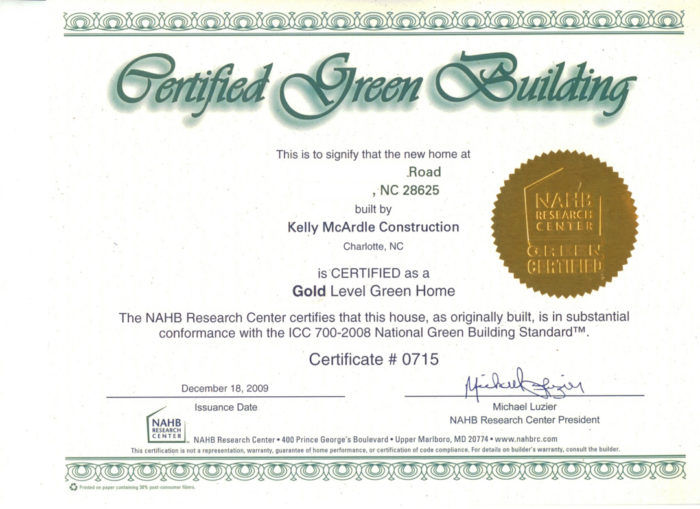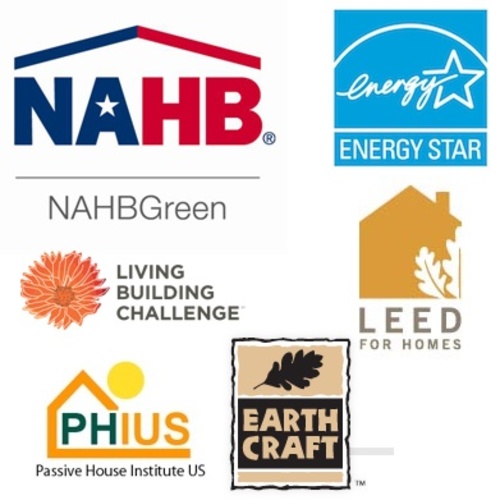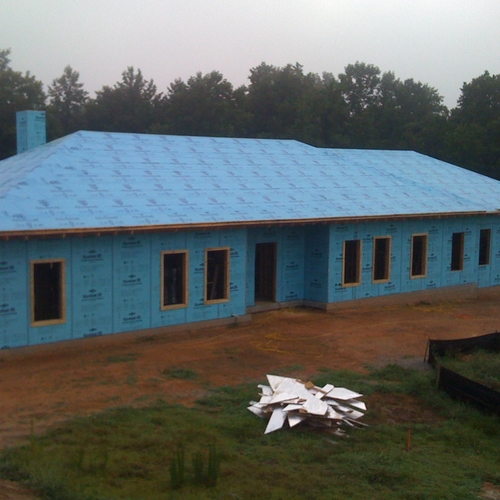
Image Credit: Danny Kelly
Image Credit: Danny Kelly A handsome kitchen. This is the kitchen in Danny Kelly's EarthCraft home.
Image Credit: Danny Kelly An elegant ceiling. This is the living room in Danny Kelly's EarthCraft home.
Image Credit: Danny Kelly A bright, white kitchen. This is the kitchen in Danny Kelly's Energy Star home.
Image Credit: Danny Kelly One counter, two lavatories. This is the bathroom in Danny Kelly's Energy Star home.
Image Credit: Danny Kelly
Two of the green rating programs we’ve mentioned in this blog series are the LEED for Homes program and the National Green Building Standard (NGBS) developed by NAHB. The intent of these two certification programs is similar.
For the most part, the points available in each program are similar. The LEED for Homes checklist and spreadsheets are very user-friendly, and there is a decent amount of information on the Web site. We were very surprised that answers to questions about the LEED program came very slowly – it took a very long time to hear back from USGBC. I also felt that USGBC was very proprietary with their information.
The NGBS checklist was done online. The Web site was very easy to navigate; most of our questions were answered in the links as we completed each section. However, it was very cumbersome to get through the first time. I think I spent about four hours going through it. It would have been nice to just go directly to a spreadsheet to fill out.
I especially liked the sections in NGBS where it named the approved products. (With the LEED for Homes program, on the other hand, I felt like we were reinventing the wheel each time we tried to use a certain product.) Another nice feature of the NGBS Web site is that it incorporates the Builder’s Challenge into their online tool; it tells you every point that is required so you don’t accidentally overlook something.
LEED requires more paperwork
The required inspections were nearly much identical – a pre-drywall inspection and a final inspection. The two certification programs have similar documentation requirements, with one exception: the durability checklist required by the LEED for Homes program. This durability checklist seemed a little unnecessary, considering that the information was already on the plans or specs.
Creating all of the accountability forms and getting the subs to sign them was a lot of work; LEED for Homes has more monotonous paperwork.
Once we sent off our application, it took several weeks for our LEED for Homes application to get approved. In contrast, the NGBS was approved within a few days, and they even processed the Builder’s Challenge certification for us.
I’ll say one thing: the LEED for Homes certificate is the nicest I have seen from any of the programs. It came in a nice folder and was designed to look like it had been mounted and framed (even though it was not). The Builder’s Challenge sticker is pretty nice – they put our company logo on it and it has a color HERS scale on it which could be a great marketing tool when trying to explain a home’s HERS Index to a potential buyer.
Comparable stringency
Although most people think that the LEED for Homes program is much more stringent than the NGBS program, I did not find that to be the case. That may be true only on the bottom rung of each program — if you compare a LEED for Homes Certified home to a NGBS Bronze level home. One of the flaws in the NGBS program is that Energy Star Homes certification is not a prerequisite.
Once you rise up the rungs, the two programs are more in line with each other. The LEED for Homes silver, gold, and platinum levels are comparable to the NGBS gold, silver, and emerald levels.
Our Platinum LEED home — nicknamed the Mean Lean Dream Green Platinum Level LEED for Homes house — did not get Emerald certification from NGBS, only Gold. So arguably, the NGBS program is more stringent than LEED, although I’m sure if you move the points around you can prove the opposite as well.
A nice thing about the NGBS program: as you moved up each level, there were minimum scores for each division. In contract, the LEED for Homes program does not have minimums for each division — allowing you to be point-heavy in one area and weak in another. I believe that overall, the NGBS program results in a more balanced house.
Point chasing
At times I did feel like we were just chasing points, but I guess that is just the nature of these programs. There are a few requirements in these programs that are well-intentioned but may not make much sense, depending on where you are building. For example, we went through a lot of work to use locally made lumber; that meant we had to purchase some of our material from different suppliers. As a result, five different companies sent half-loaded trucks to our site rather than one large tractor trailer with all of our material in one trip. I am not sure if we reduced our carbon footprint in that case.
Another item that may not have lessened our carbon footprint: since we were trying to get a point for ceiling joists spaced more than 16 in. on center, we had to increase the depth of the ceiling joists. Sso even though we had fewer joists, we needed 2x12s instead of 2x8s — so I am not sure if we really used fewer board feet of lumber. Some would argue that 2x8s can come out of smaller trees than 2x12s — so I’m not sure how much that point-chasing really helped.
To me, green building is really about the performance of the building rather than the materials. So, even though rounding up the materials did require a lot of time and effort, I did not lose too much sleep over that stuff.
A good sales tool
Overall I have enjoyed my green building journey. I have learned a lot, and I feel our company, Kelly McArdle, is building better houses because of it. I like having a third party inspect our homes; it helps protect us and is also a good sales tool. As I had hoped, green building has really set us apart from other custom builders in our area, and we have gotten several jobs as a result of our knowledge and experience in green building.
I am constantly amazed that builders and architects who are leaders in the industry understand so little about green building. They are convinced that it is much more complex than it actually is. This new knowledge and experience has also helped get our foot in the door with some people who would not have considered us a few short years ago.
After attending some of the recent conferences, it appears that today’s green home is tomorrow’s code-minimum home. What was formerly something that set us apart is going to be required of every home builder. So as not to remain stagnant, you would be advised to get ready to walk, jog and run on your own journey to green.
Personally, I’m thinking about what we need to do to fly!
Danny Kelly is a co-owner of Kelly McArdle Construction in Charlotte, North Carolina.
Weekly Newsletter
Get building science and energy efficiency advice, plus special offers, in your inbox.















7 Comments
Green Certifications
Kelly ,one thing I think you missed an opportunity to talk about is the cost of the 2 programs for verification & certification . Also , Builders Challenge uses an E-Scale not Hers for their ratings , I do believe . Thanks for this great series of blogs on your journey to Green , I can totally relate to your journey !
Great series here
Kelly, Your series gets better every time I read it. This is a really great addition to the site and very well-written. I agree with Green Country Homes (is that you Ed Jr?) that it can be good to share the fees associated with each of the certifications. It's also really exciting news that the NAHB just took Jamie Hagar and Bill Beasley's Excel spreadsheet for calculating NGBS ANSI-700 scoring and made it available for all. This really speeds up the what-if scenario process.
point chasing
instead of actually producing energy efficient buildings that conserve energy (presumably, that was what the Leadership part of LEED was intended to stand for?), developers and architects tend to chase the cheapest points possible to maximize their 'green' investment - the result is massive greenwashing on a ridiculous scale.
"great, you used recycled countertops and bamboo flooring. how about your energy usage, was that significantly reduced? what's that, it was more expensive than a bike rack so you only did the pre-reqs? outstanding... mission accomplished"
until LEED moves closer to passivhaus/minergie on mandating significant energy reductions, it comes across as a pyramid scheme. add in the overly bureaucratic process for LEED - and it gets even more ridiculous.
Point Chasing and Added Value
I agree Mike, point chasing can be a worthless, futile, expensive smokescreen.
"Oh, but the LEED Platinum house is worth more on the market" Sorry, but there is absolutely no proof of this yet. Too many other factors are more important to homebuyers, and the average homebuyer understands none of the energy-related issues.
The consumer education process is occurring slowly, and homes are proving to be too complex for a simple "EPA mileage rating".
Cost for Verification & Certification
Yes - Green Country and Michael - I was initially going to include that but I wasn;t confident I had a great feel for that portion and did not want publish something that wasn't all that accurate. Since we already doing the LEED-H certification our rater gave us a huge discount to add in the NGBS so would have been a little unfair to say that LEED was more expensive. Since then I have had a few more encounters with this and it does sem that most raters are charging a little more for the LEED. There is of course many factors when getting prices but for our homes, seems like Energy star is in the $400 - $600 range - to add in a NGBS certification is another $500 or so to the rater. The LEED seems to be starting around $1500 from what I am hearing. A few of the raters have begun charging a base price for "certified" and then charge a little more for extra points, saying that is extra work. So everyone seems to be doing it differently.
Yes - Michael - since I've written this I see NAHB now allows a new spreadsheet to be used. That will save the experienced builders a lot of time and the tool is still great for first timers or homeonwers.
As for the point chasing - I think it is inevitable, which is why I think the NGBS should at least make Energy Star a prerequisite. In our case, we had the energy efficiency covered so our chasing was soley to increase the level of the certification. I think a lot do it just to get a basic certification which is where the greenwashing comes in. I would like to think we are a little better than that.
Thanks for all the great comments.
Completely unconvinced
I'm far from clear that LEED has anything at all to do with green or sustainable.
Locally, there's a large private home being built that is supposedly LEED something-or-other, but the quantity of resources being put into it is anything but sustainable, and it's taking years to build. Only a tiny fraction of our population could afford such a thing. Locals who are aware of the project, including many who are benefiting financially, see what a stretch this is.
A small commercial building that's already completed was also apparently LEED certified, but again the massive commitment of resources makes it far from a model project. The fuel and equipment devoted to blasting and excavation alone could have provided wells and water distribution for thousands of third-world residents, but instead we have upscale condos and retail space, with a "green" stamp.
I suppose these projects could have been worse, and maybe that's the point of LEED, but at this point the general public is equating LEED with green, when I see absolutely no evidence to support that. It's an embarrassment to the building industry in this country.
We researched both programs
We researched both programs and a couple others trying to decide which ones to pursue and we came to similar conclusions. We did determine that the programs other than NGBS & LEEDS are primarily driven by market oriented companies and not really for better building purposes. LEEDS had our attention but our company only works the NGBS program for now. Good article!
Log in or create an account to post a comment.
Sign up Log in